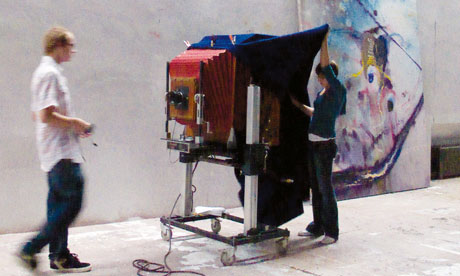Julian Schnabel's Polaroids: 'Smoke and mirrors and happy accident'
We know Julian Schnabel as a painter (the plates) and as a film-maker (The Diving Bell and the Butterfly). Now, with an old handmade Polaroid camera and a little help from his friends, he is making stunning photographs

Julian Schnabel is an American renaissance man. In the 80s, he attracted international media attention for his large-scale "plate paintings". He went on to become a notable film-maker and, in 2007, his film, The Diving Bell and the Butterfly, about French editor Jean-Dominique Bauby, was nominated for four Oscars. Now, although he continues to paint and make films, he has found himself for a third time – as a photographer.
His accomplice in this – and he refers to it as if describing a venerable, trusty friend – is his Polaroid camera. It is one of only six in existence: a 20x24in 1970s handmade machine. It is huge, cumbersome, intended for studio photography and greedy for flash lighting. But for Schnabel, it has been a revelation. He started taking photos as a personal record but became amazed by what his camera could do. "This camera works like photosynthesis. It is as if you were Xeroxing your own face. The pictures have such physicality: their surface is like fine leather, stained from chemicals. Each one has a body and is more than an image."
When I ring him, it is tea time in New York. Halfway through our conversation, he volunteers: "I can see giant boats sailing down the Hudson river, going through concrete columns." It is not the answer to a question, but it is good to hear.
I suspect it is characteristic of Schnabel to wish to place himself pictorially in the moment. In the introduction to his handsome book, Julian Schnabel: Polaroids, he writes: "Traditionally, photography is supposed to capture an event that has passed; but that is not what I'm looking for. Photography brings the past into the present when you look at it…"
It is an intriguing remark, because so many of his photos – he loves sepia – seem to exist outside time. They describe an invented past. Take the photo of one of Schnabel's twin sons, Olmo. It is a sepia image in which the boy's face stares out beneath a headscarf. He looks, as Schnabel notes, like a Moroccan peasant woman. The image has authority, but is a sober fiction.
Then there are the disturbing "crazy people". Schnabel explains: "I turned 3x3in pictures of people hospitalised in a 19th-century asylum into 24x20in prints." Lost souls – found. The pictures ask: who owns these images? "I wanted to make pictures where you would not know who took them. I also bring the present into the past."
There are several arresting self-portraits. The intention here, too, is that the photographer should remain mysterious. They should look as if "taken by someone else". He loves what over-exposure can do and revels in the moments when "you cannot extract the material from the image". Sometimes, he paints on to the images in ink, as if writing on to "infinite fog". Yet most of the pictures were taken in daylight in his studio on 11th Street. The process is slow. He sees the pictures as "smoke and mirrors and happy accident". He recognises himself in them. The portrait with a blurred dog, Milton, is "pretty much me. Milton is dead now. I loved him. He was something else."
There are extraordinary portraits of Schnabel's friends here: Mickey Rourke, Plácido Domingo, Lou Reed, Takashi Murakami. Is there any difference between photographing celebrities and family? "I know Lou, he lives across the street. He is like my family." In one portrait, Reed seems to have halted after a "walk on the wild side", ceremonial sword in hand. "He looks like Andrei Rublev in the Tarkovsky film," enthuses Schnabel. Another friend is similarly armed: Plácido Domingo. "I asked him to come over and bring some armour." Domingo obliged with full Simon Boccanegra kit. "He is as if out of another century – spectral."
In a second, tremendous picture, Domingo sits in operatic darkness; his eyes, with a tragic gleam, are the subject. As for Japanese artist Takashi Murakami, he is "a sweet guy – jovial and funny. But sometimes, I think he might have a deeper answer than the one I get from him".
Meanwhile, the photos of Mickey Rourke bring out his vulnerability. "He is vulnerable in real life," says Schnabel. "He has this brash, tough-guy demeanour but he is soft… Mickey, Chris [Walken] and Lou are all super-shy and pretty uncomfortable. These pictures happened almost by accident. They needed their pictures taken for some reason. And then it is all about trust – making pictures that are intimate."
Julian Schnabel Polaroids is at Colnaghi gallery, 15 Old Bond Street, London W1 until 12 November. An accompanying book written by Petra Gilroy-Hirtz and published by Prestel is out now


















Geen opmerkingen:
Een reactie posten